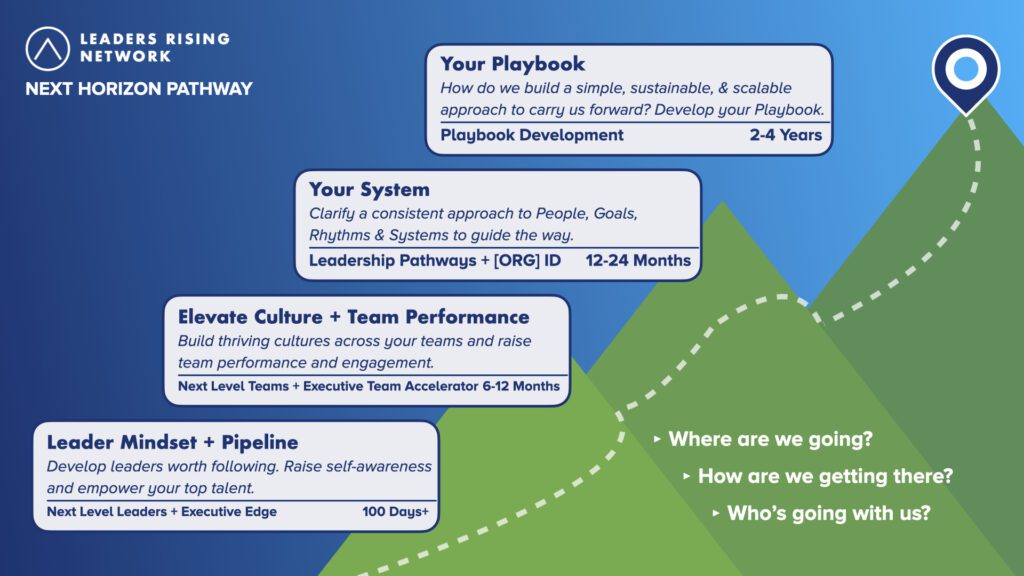Only 11% of executives say their leadership development efforts are working. That should stop us in our tracks.
If you’re a founder, executive, or HR leader in a growth-stage company, you probably feel the tension already. You’re trying. You’re investing. You’re hosting trainings and buying platforms. But somehow, the ROI feels fuzzy. Culture drifts. Turnover rises. Leaders don’t step up.
In our latest episode of the Leaders Rising Podcast, the team digs into an eye-opening stat from a recent Training Magazine report:
Only 11% of executives are satisfied with their leadership development initiatives
This isn’t just a data point. It’s a signal. A system problem. And the cost of ignoring it is steep.
So let’s break it down.
The Root of the Problem: Intention Without Infrastructure
Most organizations want great leaders. They believe in people development. They even allocate budget for it.
But belief isn’t enough.
As Becky Rivest put it on the show: “You can’t just want good leaders. You have to build a system to grow them.” That requires architecture. Not just activity. And that’s where most companies fall short.
We often walk into companies that have cobbled together a patchwork of programs—an outside training here, an internal coaching initiative there—but none of it is integrated. None of it connects to a larger plan. As Jeff Lovell shared, “There’s a leak somewhere. And it’s usually not in effort. It’s in structure.”
So what does that structure look like?
From Fragmentation to Frameworks: What Actually Works
At Leaders Rising, we use tools like [ORG] ID and 5 Voices to create systems that are clear, repeatable, and human-centered.
Here are three key shifts we guide clients through:
1. Move from Events to Rhythms
Leadership development isn’t a one-time workshop. It’s not a summit or an offsite. It’s a rhythm—intentional practices that are woven into everyday leadership life. This might look like:
- Weekly 1:1s that include feedback loops
- Monthly team voice mapping using the 5 Voices
- Quarterly Role ID reviews tied to business outcomes
2. Align Development to Role ID
If you’re not clear on what success looks like in each leadership role, your development will miss the mark. We help companies define Role ID so that development is tied to the actual expectations of leadership—not just general skills.
- What are the 3–5 outcomes this leader is responsible for?
- What decisions should they be making? Which ones should they not?
- How does this role reflect the organization’s cultural DNA?
3. Prioritize Multiplication Over Information
As Mike Pumphrey shared on the episode, “We’ve spent centuries focused on knowledge transfer. But now we need relational transformation.” That’s why we use the Intentional Multiplication Model:
- Inform: large crowds, inspirational, one-way communication
- Train: classrooms, minimal interaction, content-heavy
- Coach: small groups, lots of discussion, collaborative learning and application
- and Apprentice: personalized, customized, slow and intentional
Leadership grows when people are seen, supported, and stretched—not just taught.
A Real Example: Going Low-Tech to Get Results
One client, a regional nonprofit, made a bold decision: they deprioritized tech-based leadership tools and doubled down on in-person, relational development. Their approach? High touch, not high tech.
This wasn’t nostalgia. It was strategy.
They recognized that their mission required deeply aligned, deeply trusted leaders. So instead of outsourcing development to digital modules, they invited LRN to build development into the meetings, conversations, and rhythms they already had.
- We used the 5 Voices framework to build team trust
- We infused Role ID into staff evaluations
- We helped senior leaders coach, not just manage
And it worked.
Engagement rose. Clarity spread. People stayed longer and contributed more.
The AI Factor: Why Clarity Matters More Than Ever
Here’s the irony: this Training Magazine report was released in the context of AI trends in leadership development. But what AI is really doing is revealing your foundation.
As Jeff Lovell put it, “AI is an amplifier. If your systems are unclear, AI will accelerate the chaos. If your systems are strategic, AI will help you go farther, faster.”
AI won’t fix your leadership gaps. But it will expose them.
That’s why your investment in leadership development must be rooted in something deeper than tech—it must be rooted in culture, clarity, and consistent practice.
Want to Start? Begin With a Map
The episode closes with a powerful metaphor: leadership development starts with a map. Not a curriculum. Not a guru. A map.
Here are six questions from the Training Magazine article (page 26) that can help you get started:
- Are other companies trying to recruit your leaders?
- Are you attracting high-potential future leaders?
- Can your leaders name their development goals?
- Are your leadership efforts aligned to business outcomes?
- Is your development plan integrated with your cultural values?
- Do your people systems support daily leadership habits?
Pick one of those questions. Bring it to your next team meeting. Don’t solve everything at once. Just start the conversation.
Final Word: Stop Hosting Workshops, Start Designing Systems
If you take nothing else from this episode or article, take this from Becky:
“Don’t host another workshop.”
Instead, define your intention. Then build the system to match.
The truth is: 89% of leadership development fails. But it doesn’t have to. You don’t need more activity. You need more intentionality.
So draw your map. Build your system. Develop the leaders your culture deserves.



